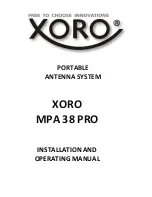
Australian Shepherd Installation Instructions
Required Tools & Accessories
Drill and 0.1 IN Drill Bit
Phillips Screwdriver
1.5 IN Hole Saw
SMA Wrench
Mounting Instructions
Antenna Mounting Location Directions
When selecting the location of an antenna, consider the following factors:
1.
Conductive Panel
–
The ground plane is a part of the antenna. If
no ground plane/metal surface is used, the antenna may
radiate in undesirable locations and may also result in bad
return loss and poor efficiency.
Parsec suggests using a 2
0”
x 2
0”
ground plane for all our
mobile antennas (PTA0587) for best performance. If this much
space is not available, use a ground plane/metal surface large enough such that it is at least 5
inches from each side of the antenna.
2.
Antenna Directionality
–
the direction of the signal is limited
by the directionality of the antenna.
Omni-directional antennas provide a 360-degree horizontal
radiation pattern, allowing for coverage in all directions
horizontally with varying degrees of vertical coverage.
When selecting the location of an omni-directional antenna,
ensure that the antenna can be mounted in the proper
orientation relative to the horizontal plane.
3.
Signal Path Loss
–
signal strength is greatly affected by the
materials that the signal passes through.
Severe signal loss can be caused by concrete and brick walls. Metals can absorb and/or reflect the
signal, affecting the signal path. For best antenna performance, select an antenna location with
minimal obstructions between the antenna and the signal source(s).
4.
Reflection & Diffraction
–
the signal will bounce off certain materials and bend around obstacles.
For best antenna performance, the antenna should be installed in a location where the signal path
is not interfered with by materials like Low E glass, Metal, Tinted glass, etc., that reflect RF Energy.
AUSTRALIAN SHEPHERD
Installation Instructions

























